Diane’s Newsletter 17th April 2018
A is the first letter (and the first vowel) of the alphabet. In English it is the third most common letter (in Spanish and French it is the second most common letter). There are at least seven different pronunciations associated with A, depending on the country/region.

A usually denotes that which is best (a student, fruit, accommodation. . . ). A tends to give the impression that something surpasses everything else in the same group.
However, the letter does also have negative connotations. For example, in The Scarlet Letter by Nathaniel Hawthorne, Hester Prynne, is forced to wear a scarlet A on the bodice of her dress when, after giving birth, she refuses to say who fathered the child. For the Puritan society of seventeenth century Boston adultery was something that could be punished by execution.
On a lighter side, the letter a is used in algebra to represent known quantities and in geometry A is one of the letters used to represent lines, segments etc. The capital A can also refer to an angle in a triangle, while a refers to the side opposite the angle. It can also be used to denote size (for example shoes).
From a numerology perspective A = 1. A is a leader, independent, assertive and strong willed. Its colour is red, and it almost always has a lot of energy, original ideas and a creative approach; it is also ambitious. On the negative side, A can be stubborn and, at times, even selfish.
AOTEAROA
As I mentioned in the beginning of this Newsletter, we have just got back from New Zealand, for which the Maori word is Aotearoa. This was a complete coincidence: A was not chosen as the letter for April because we were going to New Zealand, and we did not decide to visit New Zealand (or Aotearoa) because A happened to be the month’s letter. It just worked out that way.
From what we saw of the South Island, where we spent all our time, it is a beautiful country and definitely worth another visit or even visits. Those of you with Instagram accounts should have been able to follow our journey between Queenstown and Christchurch via the photos I posted there. I have also placed a few photos here on my website.
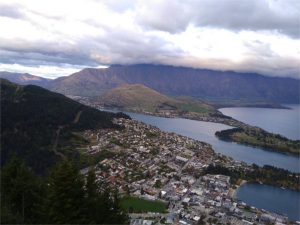
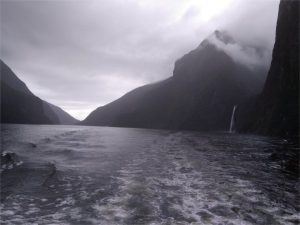
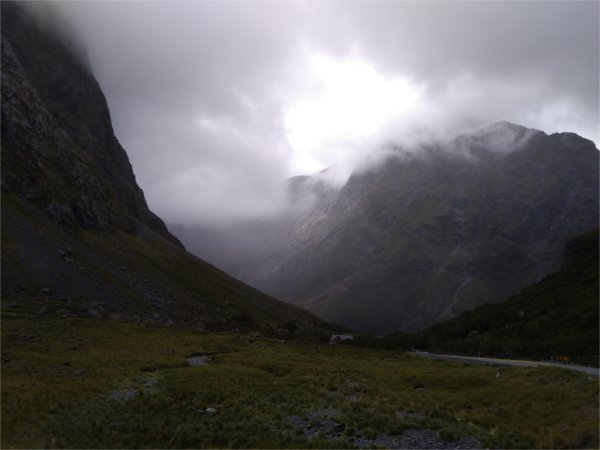
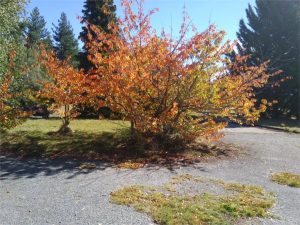
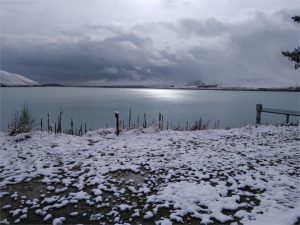
While I was putting together the Newsletter, I came across a passage in a book where the words anxious, afraid and annoyed all appeared in the same sentence. That one can be anxious, afraid and annoyed at the same time is highly likely; however, the thing that struck me was the fact that all these words begin with A, which is this month’s letter of the alphabet.
The discovery set me on a search for other mood or emotion or ways-of-being words that begin with A. You can, for example, feel:
alarmed, adequate, appreciated, ambivalent, abrasive, awake, admired, abandoned, amused, acerbic, animated, aware, accepted, abrupt, alone, ancient, accomplished, astonished, aloof, accommodating, adventuresome, aggravated, abject, ambitious, awestruck, appealing, apprehensive, affluent, abstracted, alienated, apologetic, alert, admirable, affable, anxious, assured, augmentative, adroit, accursed, amenable, ageless, accountable, active, angry, amazed, agile, able, adorable, austere, assertive, animated, ardent, average, antagonistic, amusing, abnormal, adaptable, abominable, abstemious, angelic, alluring, annoyed, alive, aimless, aggressive, affable, abashed, afflicted, attractive, apathetic, ambiguous, acidic, anguished, absent-minded, agitated, altruistic, accused, afraid, amiable, awed, awful, approved, arrogant, agreeable, alluring, awkward, affectionate, absurd and ashamed. . .
It is possible that there are many more such words beginning with A, but this is a start.
Alison Booth published her newest book, A Perfect Marriage, on the 22nd March. She is an Australian author and is probably best known for the Jingera Trilogy. She was featured in my Newsletter, March 2017.
A Perfect Marriage has been published by RedDoor, UK, and, according to their website, A Perfect Marriage is about Sally Lachlan ‘. . . (who) has a secret that has haunted her for a decade; is it time now to let it go? A chance meeting with the charismatic geneticist, Anthony Blake, reawakens her desire for love and at the same time, her daughter, Charlie, shows signs of wishing to know more about her father. Both the past and the future are places Sally prefers not to think about. . . ‘
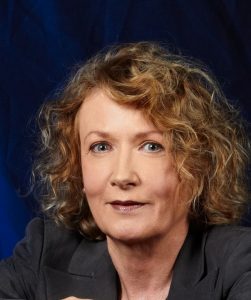 A Perfect Marriage is available from most book shops; it is also available online.
A Perfect Marriage is available from most book shops; it is also available online.
The photo of Alison Booth is from ANU
You can read more about Alison and her books on her website.
GUEST POST by ANGELIKA

YINYOGA
Efter mina barn- och ungdomsår i olika skolor i Lidköping, var gymnastik det ”värsta” ämnet i skolan, det visade sig även i betygen … Detta har gjort att jag inte velat medverka i gymnastiksgrupper av allehanda slag.
Jag har med åren fått ont lite här och där och är mest besvärad av artros i vänster knä och ont, utsliten, höft, jag har även Ankyloserande spondylit – Bechterews sjukdom, som beror på inflammation, framförallt i muskelfästen och leder. Man får ont, blir trött och stel. Smärtan kommer och går i perioder.
I november 2017 lockade min arbetskamrat med mig på ett prova-på-pass med Yinyoga.
Jag som inte kan ligga på knä för jag har så ont i dem, låg 2 x 5 min på knä utan att ha ont.
Jag som i 30 år haft en kudde mellan mina knän för att avlasta korsryggen, inte ens kunnat ligga 5 minuter på sidan utan kudde, innan jag fick ont, jag har sedan den enda gången kunnat klara mig utan kudde mellan knäna! T.o.m. under hela natten, och jag sover alltid på sidan.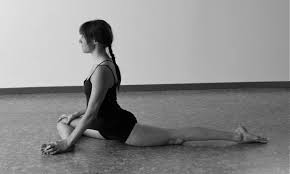
Jag övervann min motvilja till gruppträning (vi är ca. 8 st. och tre är mina väninnor) och anmälde mig på en gång till vårens alla pass från januari till maj 2018.
Jag ser fram mot Yinjoga-träningen varje vecka – fast vi ligger både på rygg, mage, och kryper runt på en tunn yogamatta med bara ett ullskinn på. Vi gör ställningar som ”hunden”, ”barnet”, ”trollsländan”, ”svanen” ”happy baby” och mycket mer. Och det mest fantastiska av allt är att jag klarar av rörelserna utan att ha ont och det blir bättre och bättre för varje vecka!
Jag är överraskad av mig själv – för att inte tala om vad min dotter är, som också yogar och gör liknande rörelser som jag! Hon tror inte mamma klarar av detta, men vi gjorde ett pass ihop på min yogamatta nu i påskhelgen, och hon var ”chockad” att jag klarade av detta. (Och jag stolt.)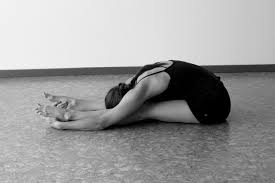
På bara några veckor klarar jag av att böja upp min utslitna? höft och kan smörja in min vänster fot, ta på mig strumpor, o.s.v. – har inte klarat detta på minst tre år. Jag tycker jag fått ett nytt liv. Det hade jag inte räknat med när jag började med Yinyogan i januari månad.
Kanske min höft inte är utsliten utan att mina senor och muskler inte är tillräckligt uttänjda – för det är vad vi gör på Yinyoga-passen. Vi tänjer kroppen i 5 minuter och vilar i 5 minuter, sedan gör vi en ny rörelse i 5 minuter och vilar i 5 minuter o.s.v. så gör vi i 1,15 h. Då jag har ett sittande arbete, blir inte höftmusklerna uttänjda och de blir förkortade.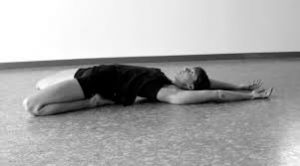
Jag är så väldigt tacksam att min arbetskamrat ”lurade” med mig på det första yoga-passet. Jag sörjer redan att kursen är slut i maj – och ser redan fram mot höstens Yinyoga-pass.
Av Angelika Bristle Folkesson, Vara, Sverige.
GUEST POST by ANGELIKA
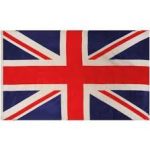
YIN YOGA
During my childhood and teenage years, I attended various schools in Lidköping, and physical education or gymnastics was always the subject I liked least, a dislike that was reflected in my marks. Consequently I avoided all kinds of physical education activity.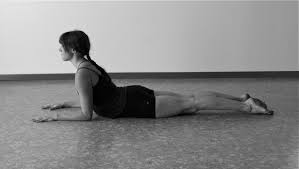
Over the years I have suffered the odd pain here and there, but I have been most troubled by arthritis in my left knee as well as by a painful, worn-out hip. I also suffer from Bechterew’s Disease (Ankylosing spondylitis), which is an inflammation of the muscle attachments and the joints. The symptoms are pain, tiredness and stiffness, with the pain usually coming in bouts or periods.
In November 2017 a work colleague talked me into attending a free session of Yin Yoga.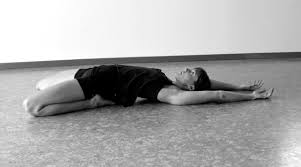
Although I am normally unable to kneel because of the pain in my knees, after this one session I could kneel 2 x 5 minutes without experiencing any pain.
Although, for the last 30 years I have always had to have a pillow between my knees to relieve my lower back, and I have not been able to lie for more then 5 minutes on my side without experiencing pain, after just one session I could manage without a pillow between my knees, and I was able to sleep all night (I always sleep on my side).
I conquered my aversion to training in a group – we are about 8 in the group, 3 of whom are my girlfriends – and I immediately registered for the spring course: January – May 2018. Now, in spite of the fact that I have to lie on my back and stomach and crawl around on a thin woollen yoga mat, I find myself looking forward to my weekly Yin Yoga session where the poses (or exercises) have names such as “the dog”, “the child”, “the dragonfly”, “the swan”, “happy baby”. Most fantastic of all is the fact that I am able to do the exercises without experiencing any pain, and it simply gets better and better with every passing week.
I am more than surprised by what I can already do, as is my daughter who is also into yoga and does similar exercises to mine. She would not believe that Mum was able to do such exercises, but over the Easter weekend we had a session together on my yoga mat and she was shocked that I actually managed them. (Imagine how proud I felt!).
After only a matter of a few weeks I am able to move and bend my worn-out (?) hip; I can even do things like oiling my left foot or pulling on my socks – things I have not been able to do for at least three years. I feel as though I have been given a new lease of life, something I had not expected when I began with Yin Yoga in January.
Perhaps my hip is not worn out at all, and it is simply a case of my tendons and muscles not having been sufficiently stretched – because that is what we do at Yin Yoga. We stretch our body for 5 minutes and then we rest for 5 minutes, then we do an new exercise for 5 minutes and rest for another 5 minutes, and so on for one hour and fifteen minutes. As I have a sedentary job, my hip muscles do not get enough stretching and, as a result, they become shortened.
I am so thankful that my work colleague talked me into giving Yin Yoga a try, and although I am sad that this course will be finishing in May I am already looking forward to autumn’s Yin Yoga course.
Angelika Bristle Folkesson, Vara, Sweden.
All images from wikimedia
ANTARCTICA
For years I have dreamt of visiting Antarctica. Long before all the tours and cruises that now transport people to that continent I imagined what it would be like to visit a place that was so vast, so empty, so quiet and, of course, so cold. Dreams do not always eventuate and now the cost of travelling there as a tourist is completely beyond the reach of normal people.
Taking a cruise from Argentina (the closest point to Antarctica), you can expect to pay more than $10,000 for a 10-day cruise; however, if you travel from Australia, you can pay $30,000 – $50,000 for a three-week cruise. Because of location and distance, the cruises from Australia are always going to be longer than those from Argentina (but travelling from Argentina is usually also going to entail air travel, and this cost must be factored in to the overall cost). However, not being a cruise person, these alternatives (apart from the cost) do not really appeal – perhaps I should have been a scientist, and then I could have got myself involved in one of the scientific expeditions. . .
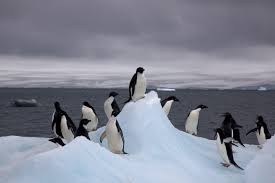
The word Antarctica actually means the opposite to north (i.e. the opposite to Arctic). It is possibly interesting to know that when Australia was named Terra Australis (the south land) no one suspected that there was actually a continent further south than Australia. By rights Antarctica should have been named Australia, but perhaps Antarctica (the opposite to north) works just as well.

The entire continent, most of it above 3,000 metres in elevation, is covered by a permanent layer of ice, and it is the coldest place on earth – the lowest temperature recorded being -89.2°C. The ‘summer’ months (temperatures between 5°C and 15°C) are constantly light, whereas winter is constant night. From what I can gather the only people living there are scientists and other people manning research stations. The original countries that claimed territory on the continent are Australia, Argentina, Norway, France, Chile and New Zealand; however, in 1959, several other countries also made claims: Belgium, Japan, USA, South Africa and Russia.
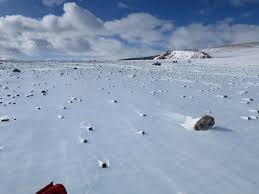
It is undoubtedly a beautiful place, and we can only hope that it can maintain its isolation and natural beauty in an age when so many big companies are only motivated by the profits to be made both above and below the ground.
Anne Askew (Ayscough, Ascue)
I was going to say that history is littered with examples of man’s inhumanity to man; however, it may be more correct to say that it is actually composed of such incidents. I have no idea why this is the case; perhaps humankind suffers from a serious inferior complex or some other psychological disorder. Who knows. . .
We are all familiar with the bloodshed and the slaughter that coloured not only the reign of Henry VIII but also the reigns of both of his daughters. To my way of looking at it, the killing was unnecessary – why should everyone have to share exactly the same set of beliefs? (But perhaps the answer boils down to that inferior complex I mentioned earlier. . . ).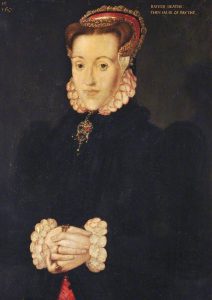
One of the people executed during the reign of Henry VIII was Anne Askew (Ayscough, Ascue). I found myself attracted to her not only because of her bravery but also because, in many ways, she was one of the first feminists. Born in Lincolnshire (which is north of London and south of York), she was, from all accounts, an extremely intelligent and well-read woman; she was also a devout Protestant, which did not stop her being forced into marriage (at fifteen years of age) to Thomas Kyme, a Catholic. It is difficult to understand how such a marriage could have even been considered given the erratic religious atmosphere of the time.
From what I can gather, Thomas was not a model husband, and eventually, deciding that he actually did not want to be married to a Protestant, he sent his wife packing. She, possibly relieved to finally be rid of him, began to consider divorce, which, given the time, was unheard of.
Anne travelled to London where she joined together with like-minded Protestants, all of whom supported Martin Luther, and began preaching. In 1543, Henry had decreed that it was illegal for women and any man below the rank of gentleman to read the Bible, and reading the Bible is exactly what Anne and her friends were doing. While in London she approached Henry and requested a divorce from her husband, but her efforts were unsuccessful and, according to some accounts, she was ordered to return to her husband. Other accounts claim that Thomas, unhappy about the turn of events, recalled his wife to the marital home in Lincolnshire. Whatever the case, Anne, having tasted freedom, escaped back to London. In 1545, when she was only 24 years of age, her husband had her arrested on the grounds that she was a Protestant, that is to say, a heretic. That her husband would have had her arrested on such grounds was a bit underhand, seeing as he would have already known of her beliefs before he married her. Anne’s father’s position as a member of Henry’s court made no difference to the outcome, and Anne found herself in gaol.
She was soon released (perhaps Mr Askew’s position did count for something after all). However the following year she was re-arrested and was tortured on the rack – the only woman ever to be tortured in the Tower of London – before being burnt at the stake. The Constable of the Tower, who normally presided over such dreadful events, was very much against a woman being treated in such a manner, and he refused to have any part of it. However, the torture continued under the guidance of four of King Henry’s closest men, including the Chancellor, a bishop and the king’s secretary.
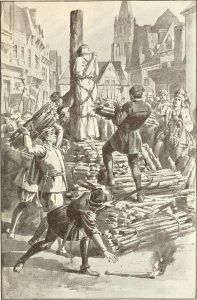
The men had nothing against Anne personally, but they wanted her to give them the names of other Protestants, and they were hoping that she would implicate the then Queen of England, Queen Catherine Parr. Anne had, unfortunately, become caught up in a power struggle between the Catholic traditionalists and the Protestant reformers. Nevertheless, she did not give her torturers satisfaction by divulging any names, and when she was finally brought to the stake for execution she had to be carried as she was no longer able to walk. According to some accounts, the executioner, taking pity on Anne, placed a bag of gunpowder around her neck, which meant that death came somewhat quicker than it otherwise would have done.
Apart from her obvious bravery and the fact that she has gone down in history as a Protestant martyr, Anne is mainly remembered for her writing. Her Examinations (an eye-witness account of the turmoil of the sixteenth century from the point of view of religion and gender) – part of which was written while she was in the Tower of London – is considered to be one of the most important testimonies from that particular period. For me the fact that she believed in something so completely and was prepared to defend her views even with the horror of execution hanging over her marks her as a very special and courageous woman.
The images of Anne Askew and the burning at the stake are from wikimedia
AMANDA’S BIRTHDAY CURRY

This wonderful curry has been contributed by Annette, and even though it is the second curry in two months curries are always amazing, and I know that you will love it. It is easy to make; it is colourful; and it tastes delicious.
INGREDIENTS
(A)
2 cloves garlic
1 brown onion
1 tablespoon Indian curry (Nurtured Earth Organics) or any curry powder
1 teaspoon Cayenne pepper (Nurtured Earth Organics) or any Cayenne pepper
1 teaspoon salt
2 teaspoons turmeric powder
1 teaspoon nutmeg
2.5 tablespoons Sunflower oil
2 medium capsicums, chopped coarsely
1 zucchini, sliced
2 cups of diced, partially cooked, pumpkin (for example, Jap)
1 medium broccoli (flower heads separated plus the finely chopped stem)
1 tin coconut milk
2 chopped carrots
2 cups baby spinach
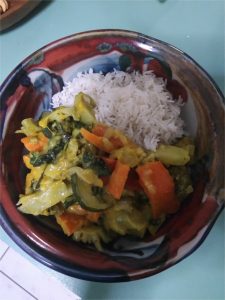
METHOD
Warm the oil in a large frying pan. Add all of (A) and let cook for a few minutes. Add the capsicum. Add half the coconut milk, and then add all the vegetables with the exception of the spinach. Add the rest of the coconut milk. Stir carefully, lower the heat and allow to cook for about 10 minutes. Just before serving add the spinach leaves and cook for an extra couple of minutes.
Serve with Basmati rice and yoghurt.
Lebanese flat bread or Greek Pitta bread slightly browned under a grill and cut into quarters can be a great accompaniment to the curry.